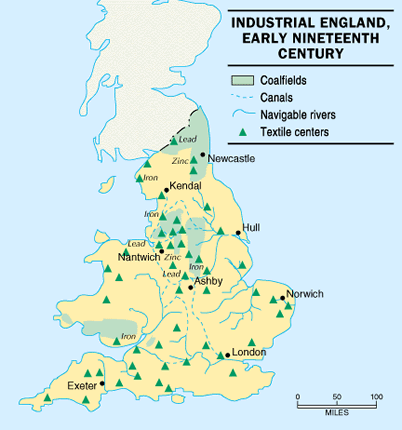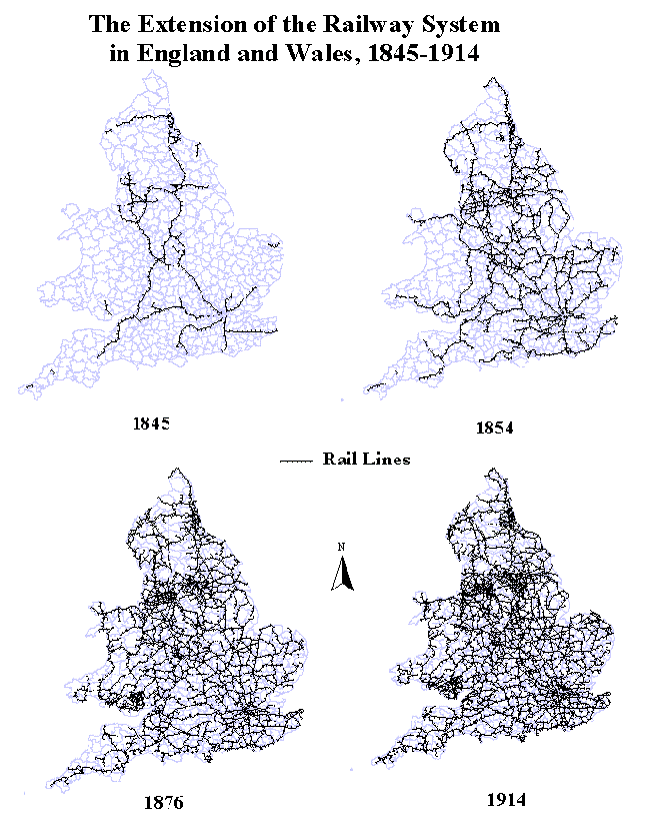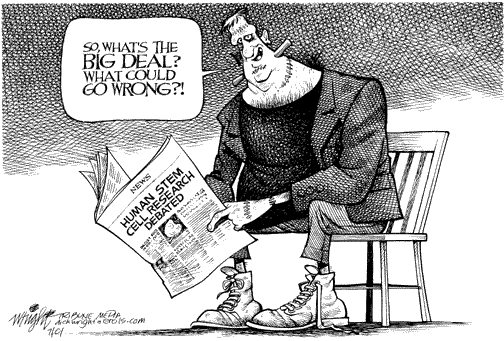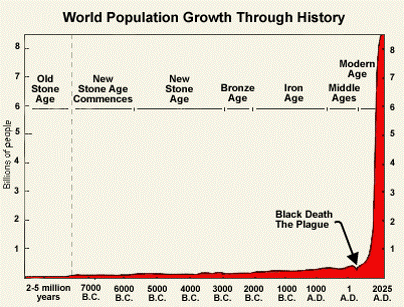Discovering History
History with Ms. Sabatos
Industrial Revolution
The Agricultural Revolution
The Agricultural Revolution began in the mid 1600s to early 1700s. Due to various inventions and new methods, farming land became easier and created more agricultural yield. However, the new methods meant less people were needed to farm, and, in some cases, farmers were simply kicked out of their land. Because people needed jobs and the population was growing, there was a workforce for the factories that began to be formed...but more on that later. Let's take a look at the inventions and new methods of the agricultural revolution!
Enclosure Movement



The Enclosure acts (or movement) throughout the UK created larger areas for people to farm; however, this meant that some peasant farmers were no longer allowed to work and live on the land they used for many years.
Improved Livestock

Selective breeding of cattle, sheep, and other farm animals began to be used widely in this time period. Farmers mated the larger animals with better attributes, ensuring their offspring would hold the attributes of their parents. Over the next few decades, the size of animals increased dramatically.
Crop Rotation

The new method attributed to Charles "Turnip" Townshend helped to ensure nutrient rich soil . By rotating the crops planted on various plots of land, the soil was able to gain nutrients and remain healthy allowing crops to prosper!
Tull and Drill

Jethro Tull created the seed drill which allowed for more farming in less time. Additionally, it planted the seeds efficiently creating a higher agricultural yield. More food!
Population Growth
Because there was more food, more people could be fed. The innovations of the agricultural revolution began a population growth that was exponential. More efficient farming led to more food being produced which allowed for better nutrition of the people living during the time. Below is a graph and a chart showing the significant population growth.


Inventions of the Industrial Revolution
Inventions Impact
Throughout the late 1700s and early 1800s, new inventions continuously changed society and industry. Some of these inventions include smallpox vaccine, telegraphs, steam engines, and cotton gins. These inventions allowed industry and factories to flourish in the new technologically advanced world.
Steam Engine
The steam engine, invented by Thomas Savory would innovate transportation and factories for decades to come. By the early 1800s, Fulton had invented the steamboat, allowing for quick travel on water. Not long after, the steam locomotive came to life, allowing for railroads to spring up across of the world. Additionally, steam engines were being used in factories, allowing machines to work faster and factories to move away from water sources.
Vaccine
Smallpox, a very deadly and easily spread disease, ravaged communities throughout the world for thousands of years. If one survived from smallpox, their body would be riddled with pox scars. While inoculation worked to an extent, Edward Jenner discovered cowpox virus would be safer and still create immunity. With this, he created the vaccine which would create immunity to small pox, allowing for smallpox to slowly disappear and become less dangerous. Watch the video above for information on the history of smallpox and Jenner's vaccine!
Telegraph

The telegraph was invented by Samuel Morse in the early to mid 1800s. Morse created a machine that would transmit signals through electricity across long distances. Morse code, named after Samuel, was created in order to communicate through the machine. The telegraph revolutionized long distance communication!
Cotton Gin
With the rapid change in factories and textile machines, such as the spinning jenny and the water frame, textiles were being produced more quickly. However, cotton was being harvested at the same rate. In the late 1700s, Eli Whitney created the cotton gin which allowed one person to take the seeds out of 50 pounds of cotton a day compared to the 1 pound prior to the machine. Now that cotton could be seeded faster, more cotton could be sent to to factories, allowing more textiles to be produced.
Why Britain?
Industrial Revolution Begins in Britian
In the mid 1700s, Britain was in the prime condition for progress economically and industrially. There were many factors to the start of the industrial revolution in Britain including a stable government, resources, and their access to water.
1. British Resources

3. Economic Prosperity
Because of stable government and the empire that had been set up around the world, Britain's economy was strong and there was room for people to improve it.
4. Jobless Farmers
The Enclosure movement created a decent amount of unemployment for farmers who had previously worked the land of their lords. Since there were so many farmers who needed work, there was a workforce available to work in factories that were being created. While the working conditions were not necessarily the best, the job paid and allowed for survival!
2. Access to Water
Being a large island off of Europe, The United Kingdom had easy access to water. In England, no one is more than about 70 miles from the coast. In addition, as seen on the map to the left, there are a great amount of waterways and canals that provide a way for transportation.
Not only does the water way access allow for easy trade to other countries, but the waterways throughout the country allow for easy transportation of goods and resources throughout the country. This provided Britain with more opportunity to succeed in a growing, industrializing world.
5. Stable governments
Britain's government, for many years, had gone through turmoil due to the Protestant Reformation and absolute power. However, by the later 1700s, Britain's government had become more stabilized. As a limited monarchy, Britain had a limited monarchy with two houses to create laws and maintain order. This allowed for the economy to flourish!


The Transportation Revolution
Turnpikes, Railroads, and Canals...Oh my!!
Railroads

Railroads, in many ways the most successful new transportation system, were created thanks to the steam engine. Steam locomotives were able to carry large amounts of goods and people from city to city very quickly. Additionally, the building of railroads occurred rapidly and created jobs. Due to the railroads system, transportation was made faster and more reliable.
Canals

In Britain, canals were a staple to the transportation of goods. Britain's canals were everywhere and led to the various seas that would take goods to other countries. Steamboats allowed for even faster transportation of goods on canals, making a more reliable system for the transportation of goods.
Turnpikes

Turnpikes started out as privately owned roads one had to pay for to travel on. Money, similar to today's turnpikes, was used for the renovation and up keeping of the roads. The intricate roads allowed for fast transportation by foot or carriage from city to city.
Social Effects of the Industrial Revolution
This is Industrial Man (let's call him IM for short). He has been living in Britain during the transition from agriculture to factories and learning how to cope with the new ways of industrial life. Unfortunately, due to Enclosure, his farm was taken away, and he had to find a new job - good thing a factory opened up by the river a couple miles away! His body and mind are riddled with things that show you how his new life works. Take a look!
Industrial Man



IM, now working in a factory, has a boss that controls his work day, making him sad since he was his own boss before.
His heart may give out soon in his ripe old age of 22 since he has begun to work in factories. Life expectancy in some cities was as low as 25 and could be as high as 40!
His diet has gone from foods he grew to what is available at teh factories such as bread and porridge.
At a factory, IM is performing unskilled labor, using a machine to perform the weaving he used to do by hand.
At the factory, since he is not his own boss, IM works anywhere from 12 to 16 hours a day!
Disease
On top of all of the work, Industrial Man is now living more closely to other people in the city the factory life has created. We know now that close living conditions can spread a great amount of disease; however, during the 1700s, they were not as aware of the way bacteria spread (or even what bacteria really was). IM could come down with any number of diseases including cholera, typhoid, typhus, and influenza. While there were doctors, IM would be subject to medical treatments that were from the medieval ages, as many medical advances did not come until later. The liklihood of dying from an illness was fairly good, hence why the life span dropped significantly in cities.
Working Conditions
Factory conditions were not at the standards they are at today. When factories first started, there were no laws or regulations saying what could or could not be done in the factories; therefore, the factory owners would do what would make them the most money. Workers would continue to work for hours on end - even up to 16 hours. On top of that, the machines were not very safe and could cause injuries such as losing a limb. If someone lost a limb, they would often not be able to work and would get fired due to their injury.
As far as children, they worked tirelessly too in order to earn money for their family to survive! Child labor laws did not come until later, so children as young as 6 were working in factories!
The Fears that Came
Luddites
The luddites were followers of Ned Ludd. Many were skilled artisans living in an industrializing society, scared the textile mills would make their jobs unneeded and obsolete. In their fear, they destroyed textile machinery such as spinning jennies and water frames as a rebellion against the industrializing society.
Fear in Literature

Often times, arts in the time period reflect the feelings of society. That said, the fear of technology permeated throughout society, including literature. On of the most famous examples is Frankenstein by Mary Shelley. The monster was a creation that was unpredictable and curious to society. Could the invention truly be accepted in society and help society? or would it continue to hurt society and its creator?
Thomas Malthus
In the early part of the Industrial Revolution, Thomas Malthus, an economist and philosopher, predicted that the population would outgrow the food source. Eventually, due to population growth and the need for food, the world would not have enough food. However, Malthus did not factor in the full effects of the industrial revolution. In a way, he feared the possibility that humans could not find a way to produce more food quickly in order to provide for the people.

The "Isms"
Nationalism
A pride in one's country or one'es culture began to become prominent in this era. People felt strongly about their social, cultural, and religious traditions. This surge in Nationalism created some conflict as people put these beliefs over that of teh country or empire that was ruling them.

Liberalsim

To be clear, liberals have changed their views many a time throughout history. However, the definition of liberalism does not change. It stresses the importance of equality and freedom in society. In the 19th century, those who were liberal were seeking freedom in their countries. Seeing as the conservative monarchs did not want to give up power, conflict would soon ensue. Liberals of the 1800s supported and fought for a constitutional monarchy or a democracy.
Conservatism
Similarly to liberalism, the definition of conservatism has stayed the same. Conservatives like to stay with tradition, and often do not want a lot of change. In the 1800s, conservatives were in support of monarchies and the absolute power that had controlled Europe for so long.

Industrialism
Let's be real. We're talking about the Industrial Revolution, an ism has to be about the industry. A multitude of issues emerged in the early Industrial era, as our Industrial Man has shown. People were unhappy in the working conditions, pay conditions, and living conditions. The proletariat (worker) wanted freedom from the bourgeoisie (middle class - factory owner)!

Communism

Alright, here is a big one. Our views and thoughts of communism today are a bit different than what Marx and Engels had thought up. They saw the conditions of industrialization and the inequality it caused. Seeing this, they wanted a solution to the conditions that were occurring. Marx said historical progress occurred with class struggle. If we think about our studies so far, he is not wrong.
With this in mind, Marx believed the industrial worker, aka the proletariat, would overthrow the bourgeoisie. When that happened, the proletariat should create a society where there is full equality and eventually the government would not necessarily be needed.
Now this has never successfully been accomplished.socialism is the stepping stone to communism and many governments who have claimed to reach communism are actually still in a socialist stage with a dictator of a sort.
The 1830 & 1848 Revolutions
France sneezes and Europe catches a cold! In both 1830 and 1848, France led the way to the revolutions that ravaged the continent. Nationalism, liberalism, and industrialism (along with little food) were the causes of many of them. Looking at France, the 1830 revolution was about gaining freedom and equality which they achieved in Louis Philipe's constitutional monarchy. However, this became corrupt and a revolution in 1848 began, ending in the rule of Emperor Napoleon III (really France? again?).
This outcome was reflective of many of the revolutions throughout Europe. While some succeeded for a short time, in many cases, the country ended in a conservative government again.
